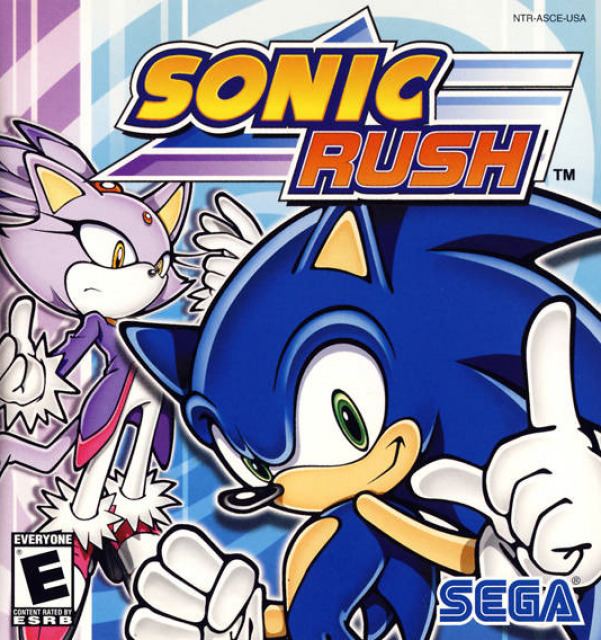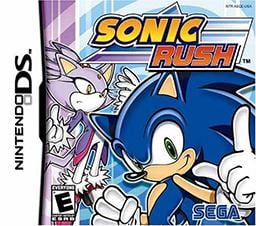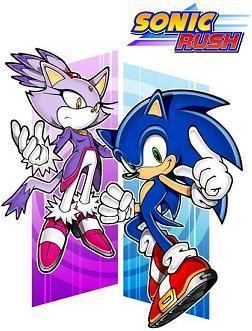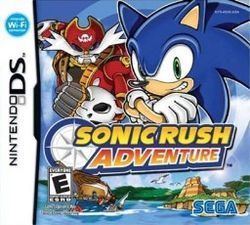8.8 /10 1 Votes8.8
9/10 IGN Initial release date 15 November 2005 | 4.6/5 Emuparadise 82% Metacritic Director(s) Akinori Nishiyama | |||||||||||||||||||||||||||||||||
 | ||||||||||||||||||||||||||||||||||
Producer(s) Yuji NakaKouichi Sakita Artist(s) Yuji UekawaKazuhiko Yamamoto Composer(s) Hideki NaganumaTeruhiko Nakagawa Mode(s) Single-player, two-player Genres Platform game, Action game Similar Sonic the Hedgehog games, Sega games, Platform games | ||||||||||||||||||||||||||||||||||
Sonic rush 100 sonic all chaos emeralds blaze extra ds
Sonic Rush (ソニック・ラッシュ, Sonikku Rasshu) is a 2005 platform handheld video game developed by Sonic Team and Dimps for the Nintendo DS as part of Sega's Sonic the Hedgehog series. It was released on November 15, 2005 in North America, November 18 in the PAL region, and November 23 in Japan. It is a 2D platform game, but Sonic's and Blaze's sprites are rendered in 3D, creating a 2.5D effect. Boss battles, along with a Sonic-exclusive special stage, are entirely 3D. The game's storyline follows the intertwining adventures of a new character, Blaze the Cat, and the series' main character, Sonic the Hedgehog. They respectively battle Doctor Eggman and his doppelgänger Eggman Nega at certain points throughout the game.
Contents
- Sonic rush 100 sonic all chaos emeralds blaze extra ds
- Nintendo ds longplay 046 sonic rush
- Gameplay
- Plot
- Development
- Reception
- Legacy
- References

The game was announced under the working title Sonic DS at Electronic Entertainment Expo (E3) 2004, and under Sonic Rush at E3 2005. The game's 2.5D format was based on Sonic Team's idea to combine elements from 2D and 3D games in the series. Upon release, Sonic Rush was positively received by critics, with praise stemming from the game's music and similarity to older games in the series and criticism stemming from its overall quickness. A sequel, Sonic Rush Adventure, was later created and released in 2007.

Nintendo ds longplay 046 sonic rush
Gameplay

Sonic Rush is a 2D platform game, similar to earlier games in the series as well as later ones like Sonic Advance. The player controls either Sonic the Hedgehog or Blaze the Cat, who differ in terms of special abilities. In the tradition of past Sonic games, gameplay consists of moving quickly through levels, collecting rings and defeating enemies. The player collects rings as a form of health; when they are attacked by an enemy, their rings bounce in all directions. If they are hit by an enemy and have no rings, they lose a life. Both of the DS's screens are used to display the play area, with the player's character moving between them as necessary. Levels in the game are divided into "zones", each consisting of two acts of normal gameplay then a 3D boss battle. The course of the game differs depending on whether Sonic or Blaze is chosen; the seven zones are the same, but are accessed in different orders. During boss battles, Blaze fights Doctor Eggman and Sonic fights an Eggman doppelgänger called Eggman Nega. As the characters' stories progress, they meet each other several times and unite in the final zone that comes after the seventh. The game features a special stages can access via certain handles in order to obtain the Chaos Emeralds. These Special Stages resemble those of Sonic the Hedgehog 2 and utilises the DS' stylus controls. Blaze, on the other hand, can't enter special stages as she earns Sol Emeralds throughout her story. When the player completes both Sonic and Blaze's stories and collect all the Chaos Emeralds, they can access a final story.
New features include a grading system that grades the player based on the time it takes for them to complete the level; they can return to levels later to try for a higher grade. There is a point system based on the one in Sonic Advance 2 but displaying points in multiple categories. There is also a "Tension Gauge" on the left side of the screen which is filled by doing tricks and defeating enemies. The energy it generates allows the player to use boosts of speed while moving; defeating enemies, moving through the level more quickly which results in more points and a higher grade, and when playing as Sonic, accessing the special stage. Although the game is primarily two-dimensional, there are three-dimensional elements which create a 2.5D effect. For the first time in the series, Sonic and Blaze's sprites are rendered in 3D. The game's boss battles are 3D.
The game has a two-player mode in which Sonic and Blaze race to the end of a chosen level from the game. There is also a feature in which players who own the game can send a demo of the game to other Nintendo DS users.
Plot
Blaze the Cat is somehow pulled from her native dimension into Sonic's world. Her world had seven Sol Emeralds—similar to the Chaos Emeralds—but they were stolen by Doctor Eggman. She then makes it her goal to retrieve them; this is where Sonic meets her. While she is searching for the Sol Emeralds, Sonic is searching for the Chaos Emeralds, which have been stolen by Doctor Eggman Nega, Eggman's alternate counterpart from Blaze's dimension. Blaze meets Cream the Rabbit and is surprised by her politeness. Meanwhile, Miles "Tails" Prower learns that Blaze's world and Sonic's are merging somehow. Sonic grows suspicious of Blaze, and along with Tails, looks for her. Soon, after they find Blaze and Cream, Sonic questions Blaze about her nature, but she refuses to give any information and leaves with Cream. Sonic follows her to Eggman Nega's base, where it is revealed that Eggman and Eggman Nega are working together to collect both the Chaos Emeralds and the Sol Emeralds. Blaze declares that she is the only one who can save their worlds, without anyone's help. Sonic and Blaze fight each other, until Sonic wins the fight and Blaze realizes the error of her ways.
After Eggman kidnaps Cream, Blaze goes after him while Sonic takes on Nega. Sonic collects the last of the seven Chaos Emeralds; and meets Blaze, who fails to protect the Sol Emeralds. Sonic and his friends help Blaze realize the meaning of friendship and she turns into Burning Blaze—apparently her answer to Sonic's Super Sonic form—while Sonic turns into Super Sonic. They fight Eggman and Eggman Nega and defeat them. The two worlds are restored, forcing Blaze to return to her own world. As she flies there, she realizes that she truly understands her powers. Later, on Sonic's planet, Cream is crying because she misses Blaze, but Sonic tells her that Blaze promised to return someday.
Development
Sonic Rush was developed by Sonic Team and Dimps, and published by Sega. Yuji Naka, Sega's executive managing director, announced the game at Electronic Entertainment Expo (E3) 2004, along with Project Rub. A demo of the newly titled Sonic Rush was featured at E3 2005, and won video game publication IGN's "Biggest Surprise" award. Blaze the Cat, a new character, was revealed at Tokyo Game Show (TGS) 2005. The game's 2.5D format was based on Sonic Team's idea to combine elements from 2D and 3D games in the series. Director Akinori Nishiyama stated in a September 2005 interview with GameSpot that Sonic Team "wanted to keep the elements from 2D, yet still explore some of the new elements from 3D." At TGS 2005, he stated that while working on Sonic Advance 3, he realized that the series was becoming more complicated, opting for a "fast, dynamic action" approach to the next title in the series. This is the first Sonic handheld game to feature the 4Kids actors who previously did voice-work for the anime Sonic X.
Reception
Sonic Rush was released on November 15, 2005 in North America; November 18 in Europe; and November 23 in Japan. It was the ninth best-selling DS game of December 2006. It sold approximately 360,000 copies in Europe, making it Sega's fourth best-selling game during the third quarter of its fiscal year ending March 2007.
The game was released to "generally favorable" reviews, according to video game review aggregator Metacritic. Critics praised the game for its usage of elements from older Sonic games. GameSpot, IGN, and Nintendo Power compared the game to older games in the series, specifically those on the Sega Genesis. GameSpy staff writer Greg Sewart offered a similar opinion, also praising the game for its "gorgeous graphics". The game's overall quickness was not as well received. GameSpy's Greg Sewart, although giving a mostly positive review, complained that "it's so fast you almost can't tell what's going on most of the time." 1UP.com and GamePro thought similarly. The game's music was well-received, called "bright [and] buoyant" by 1UP.com and compared to that of Jet Set Radio by GameSpot. GameSpy called the music "all very fitting and very catchy", noting its use of sampling and unconventional structure.
In 2008, Sonic Rush was listed at #17 in IGN's list of the top 25 DS games. On September 11, 2009, it was listed as one of the "cheers" on IGN's "Cheers & Tears" list of action games for the DS.
Legacy
Sonic Rush introduced Blaze, who has become a recurring character in the series. Blaze appeared for the second time in Sonic the Hedgehog in 2006, and then in Sonic Rush Adventure, the sequel to Sonic Rush, and numerous other games. For the 3DS version of Sonic Generations, Water Palace, a stage from Sonic Rush, was featured as a remade stage.
